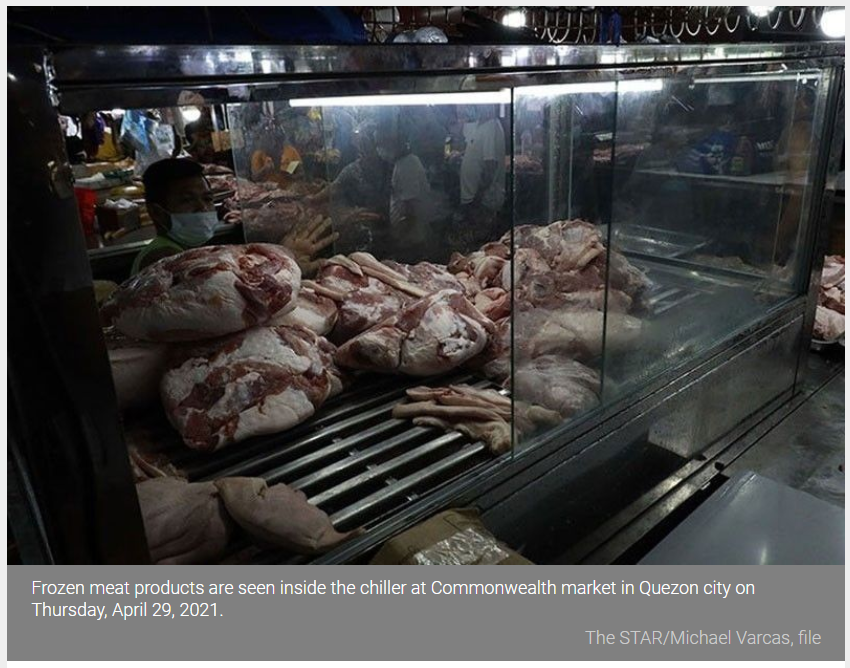Philippine pork production seen falling 40% to pre-ASF level
MANILA, Philippines — Despite a projected increase in global pork production this year, the Philippines’ pork output is seen to decline nearly 40 percent than its production prior to African swine fever (ASF), according to the United States Department of Agriculture (USDA).
In its latest report, the USDA-Foreign Agricultural Service (FAS) said Philippine pork production is expected to drop to one million metric tons (MT) this year, 10 percent lower than the previous year and almost 40 percent lower than its 1.6 million MT and 1.59 MT production in 2018 and 2019, respectively.
“At the beginning of 2021, commercial operators hesitated to repopulate due to fear of further disease outbreaks and restrictions on hog marketing meant to control the spread of ASF,” the USDA said.
“Furthermore, the government instituted temporary price ceilings on retail pork in an effort to control prices in a move that ultimately created disincentives for increasing hog production,”it said.
Data from the Philippine Statistics Authority (PSA) showed that Philippine hog production dropped 25.8 percent in the first three quarter to 421,790 MT.
Meanwhile, the USDA revised upward its forecast for global pork production to 105.1 million MT, nearly four percent higher than its previous projection of 101.5 million MT.
The USDA attributed the adjustment to higher production in China as the country’s projected production was increased by eight percent to 43.8 million MT.
“Since early 2021, China hog slaughter has been strong and carcass weights higher. Rebounding pork production at a time of weak seasonal demand has caused prices to drop rapidly, prompting liquidation of animals as Chinese producers sought to protect margins,” the USDA said.
“However, the reported culling of breeding animals, continued productivity challenges, and weaker producer margins are expected to slow China production growth later in the year,” it said.
Similarly, the USDA also revised upward its global pork exports forecast for this year to 11.8 million MT, two percent higher than its initial projection of 11.5 million MT, due to higher estimates for all major exporters.
It raised its import forecast for China and Mexico by three percent to five million MT and 985,000 MT, respectively.
“Meanwhile, Philippines imports are revised up 21 percent to 425,000 MT on lower tariffs and a continued ASF-induced supply deficit,” the USDA said.
The USDA highlighted that pork imports have been robust in the country driven by a worsening pork supply deficit and correspondingly high prices.
It recently reported that through April 2021, pork imports to the country reached 195,300 MT, up 400 percent year-over-year.
“In an effort to combat the high levels of consumer inflation caused by high pork prices, the government temporarily lowered tariffs and increased quota volumes,” the USDA said, adding that this is expected to support trade during the remainder of the year.
In May, President Duterte issued Executive Order (EO) 133, which increases the minimum access volume (MAV) for pork meat to 254,210 MT from 54,210 MT as part of measures to augment local pork supply and stabilize prices in the market.
Duterte also signed EO 134 in May, which provides that in-quota pork imports or those under the MAV are imposed a 10 percent tariff for three months and will be increased to 15 percent in the remaining months. This is lower than the original rate of 30 percent.
Out quota pork imports are slapped with a 20 percent tariff for the first three months, which will be raised to 25 percent in the remaining months. This is lower than the original tariff of 40 percent.
With the large volume of pork imports expected to enter the country this year, the USDA said this is also seen to boost pork consumption as it revises upward its forecast pork consumption to 1.4 million MT, higher than its initial forecast of 1.35 million MT.
“In 2021, higher imports have begun to allow pork consumption to recover despite continued production constraints,” the USDA said, adding that the country’s total pork consumption reached its lowest level last year since 2005 at 1.28 million MT.
“A weak domestic economy, limited purchasing power and record demand in China made competition for products fierce in the international market,” the USDA said.
Source: https://www.philstar.com/business/2021/07/14/2112268/philippine-pork-production-seen-falling-40-pre-asf-level


 Thailand
Thailand




